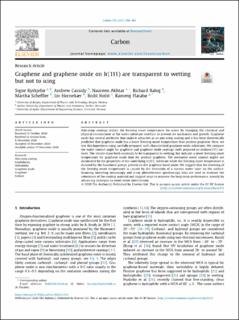| dc.contributor.author | Kyrkjebø, Signe | |
| dc.contributor.author | Cassidy, Andrew | |
| dc.contributor.author | Akhtar, Naureen | |
| dc.contributor.author | Balog, Richard | |
| dc.contributor.author | Scheffler, Martha | |
| dc.contributor.author | Hornekær, Liv | |
| dc.contributor.author | Holst, Bodil | |
| dc.contributor.author | Flatabø, Ranveig | |
| dc.date.accessioned | 2022-04-26T10:50:01Z | |
| dc.date.available | 2022-04-26T10:50:01Z | |
| dc.date.created | 2021-02-05T13:15:58Z | |
| dc.date.issued | 2020 | |
| dc.identifier.citation | Kyrkjebø, S., Cassidy, A., Akhtar, N., Balog, R., Scheffler, M., Hornekær, L., Holst, B.& Flatabø, R. (2021). Graphene and graphene oxide on Ir(111) are transparent to wetting but not to icing. Carbon, 174, 396-403. | en_US |
| dc.identifier.issn | 1873-3891 | |
| dc.identifier.uri | https://hdl.handle.net/11250/2992785 | |
| dc.description.abstract | Anti-icing coatings reduce the freezing onset temperature for water by changing the chemical and physical environment at the water-substrate interface to prevent ice nucleation and growth. Graphene oxide has several attributes that make it attractive as an anti-icing coating and it has been theoretically predicted that graphene oxide has a lower freezing onset temperature than pristine graphene. Here, we test this hypothesis using carefully prepared, well-characterized graphene oxide substrates. We compare the water contact angle for graphene and graphene oxide coatings, both prepared on iridium(111) surfaces. The results show both materials to be transparent to wetting, but indicate a lower freezing onset temperature for graphene oxide than for pristine graphene. The measured water contact angles are dominated by the properties of the underlying Ir(111) substrate while the freezing onset temperature is dictated by the functional groups present on the graphene basal plane. We suggest that the lowering of the freezing onset temperature is caused by the formation of a viscous water layer on the surface. Scanning tunneling microscopy and x-ray photoelectron spectroscopy data are used to evaluate the robustness of the coating material and suggest ways to improve the long-term performance, namely by advancing strategies to avoid water intercalation. | en_US |
| dc.language.iso | eng | en_US |
| dc.publisher | Elsevier | en_US |
| dc.rights | Navngivelse 4.0 Internasjonal | * |
| dc.rights.uri | http://creativecommons.org/licenses/by/4.0/deed.no | * |
| dc.title | Graphene and graphene oxide on Ir(111) are transparent to wetting but not to icing | en_US |
| dc.type | Peer reviewed | en_US |
| dc.type | Journal article | en_US |
| dc.description.version | publishedVersion | en_US |
| dc.rights.holder | 2020 The Author(s) | en_US |
| dc.subject.nsi | VDP::Teknologi: 500::Bygningsfag: 530 | en_US |
| dc.source.pagenumber | 396-403 | en_US |
| dc.source.volume | 174 | en_US |
| dc.source.journal | Carbon | en_US |
| dc.identifier.doi | https://doi.org/10.1016/j.carbon.2020.12.030 | |
| dc.identifier.cristin | 1887108 | |
| cristin.qualitycode | 2 | |

